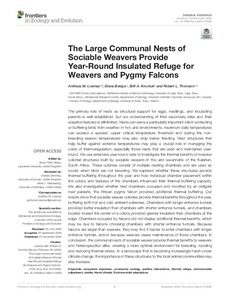| dc.contributor.author | Lowney Anthony M. Bolopo Diana | |
| dc.contributor.author | Thomson Robert L | |
| dc.contributor.author | Krochuk Billi A | |
| dc.date.accessioned | 2022-10-27T12:28:02Z | |
| dc.date.available | 2022-10-27T12:28:02Z | |
| dc.identifier.uri | https://www.utupub.fi/handle/10024/158792 | |
| dc.description.abstract | The primary role of nests as structural support for eggs, nestlings, and incubating parents is well established, but our understanding of their secondary roles and their adaptive features is still limited. Nests can serve a particularly important role in protecting or buffering birds from weather. In hot, arid environments, maximum daily temperatures can exceed a species' upper critical temperature threshold and during the non-breeding season temperatures may also drop below freezing. Nest structures that help buffer against extreme temperatures may play a crucial role in managing the costs of thermoregulation, especially those nests that are used and maintained year-round. We use extensive year-round data to investigate the thermal benefits of massive colonial structures built by sociable weavers in the arid savannahs of the Kalahari, South Africa. These colonies consist of multiple nesting chambers and are used as roosts when birds are not breeding. We explored whether these structures provide thermal buffering throughout the year and how individual chamber placement within the colony and features of the chambers influenced their thermal buffering capacity. We also investigated whether nest chambers occupied and modified by an obligate nest parasite, the African pygmy falcon provided additional thermal buffering. Our results show that sociable weaver colonies provide thermal benefits throughout the year, buffering both hot and cold ambient extremes. Chambers with longer entrance tunnels provided better insulation than chambers with shorter entrance tunnels, and chambers located toward the center of a colony provided greater insulation than chambers at the edge. Chambers occupied by falcons did not display additional thermal benefits, which may be due to falcons choosing chambers with shorter entrance tunnels. Because falcons are larger than weavers, they may find it harder to enter chambers with longer entrance tunnels, and/or because weavers cease maintenance of those chambers. In conclusion, the communal nests of sociable weaver provide thermal benefits to weavers and heterospecifics alike, creating a more optimal environment for breeding, roosting and reducing thermal stress. In a landscape that is becoming increasingly harsh under climate change, the importance of these structures to the local animal communities may also increase. | |
| dc.language.iso | en | |
| dc.publisher | FRONTIERS MEDIA SA | |
| dc.title | The Large Communal Nests of Sociable Weavers Provide Year-Round Insulated Refuge for Weavers and Pygmy Falcons | |
| dc.identifier.url | https://www.frontiersin.org/articles/10.3389/fevo.2020.570006/full | |
| dc.identifier.urn | URN:NBN:fi-fe2021042823930 | |
| dc.relation.volume | 8 | |
| dc.contributor.organization | fi=ekologia ja evoluutiobiologia|en=Ecology and Evolutionary Biology| | |
| dc.contributor.organization-code | 2606402 | |
| dc.converis.publication-id | 51289018 | |
| dc.converis.url | https://research.utu.fi/converis/portal/Publication/51289018 | |
| dc.identifier.eissn | 2296-701X | |
| dc.identifier.jour-issn | 2296-701X | |
| dc.okm.affiliatedauthor | Thomson, Robert | |
| dc.okm.discipline | 1181 Ecology, evolutionary biology | en_GB |
| dc.okm.discipline | 1181 Ekologia, evoluutiobiologia | fi_FI |
| dc.okm.internationalcopublication | international co-publication | |
| dc.okm.internationality | International publication | |
| dc.okm.type | Journal article | |
| dc.publisher.country | Switzerland | en_GB |
| dc.publisher.country | Sveitsi | fi_FI |
| dc.publisher.country-code | CH | |
| dc.relation.articlenumber | ARTN 570006 | |
| dc.relation.doi | 10.3389/fevo.2020.570006 | |
| dc.relation.ispartofjournal | Frontiers in Ecology and Evolution | |
| dc.year.issued | 2020 | |
